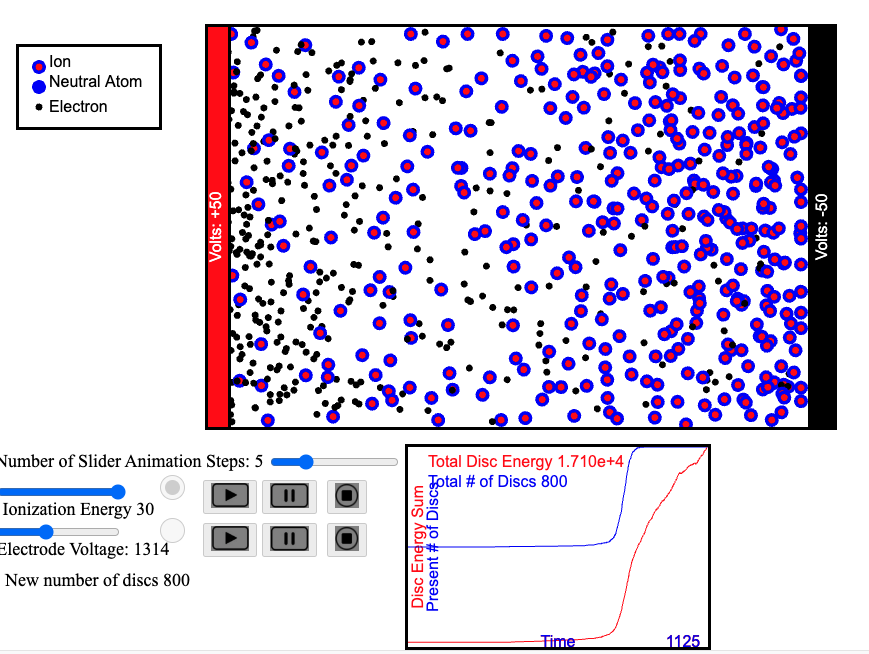Gas Discharge
Introduction
My previous work in this area is documented in
Gas Discharge Animation
but that does not include an animation. So this will include an animation.
A much more mathematical treatment is given in the wikipedia document:
Gas Discharge
Basic Physics
When a gas is subjected to an electric field, `bbE`, the charged particles (ions and electrons) are accelerated in a direction appropriate to their charges, `q`. The acceleration magnitude magnitude is dependent on their mass, m, and the charge magnitude .
`m(dbbv)/dt=qbbE`
where `m` is the particle's mass and `(dbbv)/dt` is the acceleration vector.For this animation we will assume that the ions are positively charged by the negative of the electron's charge and, to keep it simple, we will let the electron charge be -1 and the ion charge be +1. If the mean free path of these particles is long enough, then the electrons or ions can achieve sufficient energy to ionize a neutral atom and make it an ion with a charge of `q=+1` as well as create another electron which we will add to the list of particles. The created electron will have the same velocity as its parent neutral atom but its charge will be `q=-1` and its mass and radius will be smaller than its parent's. Usually the electron and ions created by these collisions will not gain enough energy to ionize another ion but, if they do, then the electron and ion density density can grow exponentially and create a discharge or an arc. Double ionization is not allowed in this program.
With this simple set of particle types and the fact that the animation is only 2 dimensional, we can label all the particles as 'discs'. So a neutral atom is a disc with zero charge, an electron is a disc with charge `q=-1` and with much smaller mass and radius than the neutral atom and an ion is a disc of the same radius as the neutral atom but a charge of `q=+1`.
How the Program Handles the Particles
We will initially define all the neutral atoms (discs) with the same energies (it's called mono-energetic) but with random velocity directions. The initial energies will be low enough that ionization will not occur. All the collisions will be simple hard sphere collisions unless one a of the colliding pair achieves an energy which exceeds the ionization energy, which is adjustable, whereupon a neutral atom can become an ion-electron pair. The initial choice of energies will be unlikely to result in any collisions where one of the discs gains an energy that is greater than the ionization energy of a neutral atom. I don't allow the double ionization of what is already an ion. As a result, if the number of initial neutral atoms is `N_n`, then the maximum final maximum number of particles (discs) will be `2N_n` because, potentially, all of the neutrals can be converted into one ion and one electron. I still need to understand why I am not seeing electrons displayed as discs of smaller radius amd of a different color. For that reason, I have provided a button which gives a cosmic ray burst that will ionize a single neutral atom and create an ion and an electron. This pair can gain energy from the electric field and will sometimes achieve enough energy which, upon collision with a neutral atom, will create another ion-electron pair.
Program Controls>
The controls are buttons and sliders (which are called ranges in HTML)
Buttons
The buttons start and stop the particle animations. Another button provides a 'cosmic ray' which alone can cause a single neutral atom to be ionized. After the atom is ionized, the electrodes attract the resulting positive ion to the negative electrode and the resulting electron to the positive electrode. Also I provide a 'Page Refresh' button that brings the entire animation to its beginning condition.
Slider Controls
The first slider provides user control over the starting number of neutral particles.
Ionization Energy Slider
This slider sets the required energy for that an atom needs to result in ionizing another ion during a collision. This is a very important parameter. Typically it will need to be less than 25 in order for an ionization to be induced. After a single ionized particle is available, that ion and its electron quickly gain enough energy from the electrode's electric field to ionize even more neutral atoms and a chain reaction occurs. Because this parameter is so critical, I have added the ability of the user to animate this slider. This is done with the ordinary play, pause, and stop buttons. So the ionization energy set at its maximum and then is stepped downward until the chain reaction occurs after which the page is refreshed so it can start again from its initial parameters. This is the first physics animation where I use of my animated sliders invention.
Electode Volts Slider
This slider sets the value of the electric field that is imposed on ions and electrons and therefore, the acceleration of any charged particles. If the electric field is small enough, then the chain reaction increase of ion and electron numbers will be very slow even after the first ionization occurs. I have added the ability of the user to animate this slider. Of course, the Electrode Volts Slider animation will have no effect when there are no particles present.
Expected Results Image
After a gas discharge has completed, there will be a rapid rise
in both total disc energy. The total number of discs will also rise
quickly to twice the original number of atom, since the neutral atoms have
each been converted to one positive ion and one negative electron.

messages